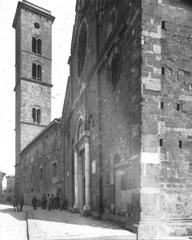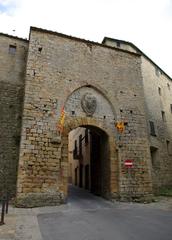Roman Amphitheatre of Volterra: Visiting Hours, Tickets, and Historical Sites Guide
Date: 14/06/2025
Introduction
The Roman Amphitheatre of Volterra is one of Tuscany’s most significant archaeological discoveries, offering a fascinating glimpse into Roman urban life, entertainment, and engineering prowess. Buried for centuries, the amphitheatre was rediscovered in 2015 near Porta Diana, just beyond Volterra’s medieval walls. This monument not only showcases the grandeur of Roman architectural design but also stands as a testament to Volterra’s prominence as a Roman municipium. Today, the amphitheatre, partially excavated and preserved, welcomes visitors eager to explore its storied past through guided tours, digital reconstructions, and engaging cultural events.
In this comprehensive guide, you will find detailed information on the amphitheatre’s history, architectural features, visiting hours, ticketing, accessibility, travel tips, and nearby attractions. Additionally, discover how ongoing archaeological work and community engagement are shaping the future of this remarkable site.
For the latest updates and official visitor information, refer to sources such as the Archaeological Superintendency of Tuscany, the Volterra Tourism Office, and reports from The Guardian.
Table of Contents
- Roman Volterra: Urban Context and Early Amphitheatre Construction
- Architectural Features and Capacity
- Historical Significance and Use
- Rediscovery and Archaeological Excavations
- Ongoing Research and Conservation
- Visitor Information: Hours, Tickets, and Accessibility
- Guided Tours and Special Events
- Impact on Volterra’s Identity and Tourism
- Future Prospects and Site Development
- FAQs
Roman Volterra: Urban Context and Early Amphitheatre Construction
Volterra’s roots trace back to the Etruscan era, but by the 1st century BCE, it had grown into an important Roman municipium known as Volaterrae. The construction of the amphitheatre in the late 1st century CE—during the reign of Augustus or Tiberius—aligned with the Roman Empire’s expansion of public entertainment venues. The amphitheatre was strategically located just outside Volterra’s city walls, next to the Roman baths, following the Roman practice of positioning large venues within easy reach yet outside congested urban centers. The natural slope of the land provided ideal support for the cavea (seating tiers), minimizing the need for complex substructures (Archaeological Superintendency of Tuscany).
Architectural Features and Capacity
The elliptical amphitheatre measures approximately 80 meters by 60 meters. Its cavea could seat an estimated 7,000 to 10,000 spectators—remarkable for a town whose population was likely under 10,000 in Roman times (Volterra Museum). Constructed from local stone and brick, the seating was divided into three main sections (ima, media, and summa cavea), reflecting social stratification.
Key architectural elements include:
- Arena: Central stage for gladiatorial games and spectacles.
- Subterranean Corridors: Used for the movement of performers and animals.
- Decorative Elements: Marble fragments and inscriptions referencing local magistrates and benefactors.
- Service Rooms: Beneath the arena for logistics and storage.
The amphitheatre’s design showcases Roman ingenuity in integrating urban planning with dramatic topography.
Historical Significance and Use
Acting as a hub for social and cultural gatherings, the amphitheatre hosted gladiatorial contests, animal hunts, and public events, reinforcing Roman authority and social values. Inscriptions and decorative fragments highlight its importance for civic pride and the Romanization of Volterra (Ministero della Cultura). With the decline of the Roman Empire and the rise of Christianity, the amphitheatre fell into disuse. Over centuries, its stones were repurposed, and the structure was gradually buried, its location forgotten.
Rediscovery and Archaeological Excavations
The amphitheatre remained hidden until 2015, when maintenance work near Porta Diana uncovered curved stone walls. Systematic excavations led by the Archaeological Superintendency of Tuscany followed, revealing the amphitheatre’s outline and well-preserved remains (The Guardian). Major findings from ongoing digs include:
- Intact seating tiers demonstrating Roman construction techniques.
- Marble decorations and inscriptions identifying patrons.
- Subterranean corridors and animal pens, providing insight into the logistics of ancient spectacles.
- Artifacts such as pottery and coins, dating the amphitheatre’s use from the 1st to 4th centuries CE (ANSA).
Ongoing Research and Conservation
Since its rediscovery, the amphitheatre has been at the center of conservation efforts, managed by local authorities and academic partners (Comune di Volterra). Priorities include:
- Stabilizing masonry and exposed structures.
- Creating digital models via 3D scanning and photogrammetry.
- Developing visitor infrastructure while preserving archaeological integrity.
These efforts ensure the amphitheatre’s protection while making it accessible for public education and enjoyment.
Visitor Information: Hours, Tickets, and Accessibility
Location: Via Porta Diana 2, just outside Volterra’s historic center.
Visiting Hours:
- Open daily from 9:00 AM to 7:00 PM (last admission 6:00 PM); hours may vary seasonally.
- From December to February, open weekends only.
- Confirm current hours via the Volterra Tourism Office before your visit.
Tickets:
- Adults: €8
- EU citizens (18–25): €5
- Free for children under 18 and Volterra residents
- Guided tours may incur an additional fee; combined tickets with other sites are available.
Accessibility:
- Paved pathways and ramps improve access, but uneven areas remain due to the site’s nature.
- Visitors with mobility concerns should consult the site in advance.
How to Get There:
- Volterra is accessible by car and regional bus from Pisa, Florence, and Siena.
- Parking is available near Porta Diana, within a short walk to the amphitheatre.
Guided Tours and Special Events
Guided tours are offered seasonally through the Archaeological Superintendency and local operators, providing expert insights into the amphitheatre’s history and function. Special events, such as ancient Roman reenactments and educational workshops, are regularly scheduled, especially during the summer months. These events offer immersive experiences for all ages and bring the amphitheatre’s past to life.
Photographers will find the site particularly appealing during early morning and late afternoon, when the Tuscan light enhances the textures and colors of ancient stonework.
Impact on Volterra’s Identity and Tourism
The amphitheatre’s rediscovery has reinvigorated Volterra’s cultural identity, integrating it into heritage trails, educational programs, and tourism initiatives. It complements the town’s other attractions, including the Roman Theatre, Etruscan Acropolis, and medieval landmarks (Visit Tuscany). The site’s integration into the local economy encourages sustainable tourism and supports community development.
Future Prospects and Site Development
Ongoing excavations and conservation projects aim to uncover more of the amphitheatre and develop visitor infrastructure, including protective shelters and interpretive panels. The combination of modern technology and community engagement will ensure the amphitheatre remains a vibrant part of Volterra’s heritage (Archaeological Superintendency of Tuscany).
Frequently Asked Questions (FAQ)
Q: What are the visiting hours for the Roman Amphitheatre of Volterra?
A: Open daily from 9:00 AM to 7:00 PM (last admission at 6:00 PM); weekends only in winter. Confirm on official websites.
Q: Where can I buy tickets?
A: Tickets are available at the entrance or the Volterra tourist information office; online booking is advised during peak season.
Q: Is the amphitheatre accessible for people with mobility issues?
A: The site offers paved paths and ramps, though some uneven surfaces remain.
Q: Are guided tours available?
A: Yes, seasonal guided tours can be booked through the tourist office or local operators.
Q: What other historical sites are nearby?
A: Explore the Roman Theatre, Etruscan Acropolis, medieval gates, and Piazza dei Priori.
Plan Your Visit: Final Tips
- Wear sturdy shoes and bring sun protection.
- Visit in the morning or late afternoon for the best lighting and fewer crowds.
- Combine your amphitheatre tour with visits to other Volterra attractions for a richer experience.
- Follow all conservation guidelines and respect site signage.
For the latest information and digital resources, download the Audiala app and follow Volterra’s official tourism channels.
Sources and Further Reading
- Archaeological Superintendency of Tuscany
- Volterra Museum
- Ministero della Cultura
- The Guardian
- ANSA
- Comune di Volterra
- Visit Tuscany
- The History Blog
- ArchaeoReporter
- WeVillas

